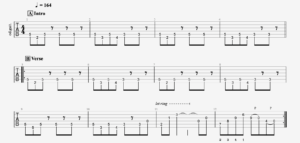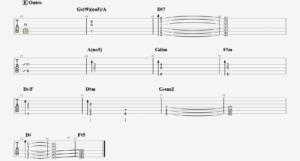Pacific 231 by Burning Airlines
Formed by ex-Jawbox guitarists Bill Barbot and J. Robbins, Burning Airlines sees them pick up pretty much where their old band left off.
From their 1999 debut album Mission: Control!, Pacific 231 is a great example of Robbins’ genius for catchy, off-kilter guitar parts which seem to studiously avoid familiar, comfortable patterns and voicings.
Burning Airlines put out just one further album before disbanding. Robbins went on to form Channels and Office of Future Plans, and as of 2020 Jawbox are back and playing live shows around the world.
Guitar tuning
The track was recorded in drop-C#: essentially drop-D, but with everything tuned down a further semitone.
Lesson
Intro and verses
The song starts out with this figure, which requires holding a fairly big stretch between the 2nd and 5th frets. To keep a steady rhythm I suggest picking notes on the 5th string with a down-stroke, and the 6th string with an up-stroke.
The verse keeps almost the same pattern, just shifting the bass note up before ending each set of 4 bars with a tricky arpeggiated figure. If you struggle with it, try starting the phrase with your second finger. That frees up your index finger to reach the E note on the 2nd string and the pull-off at the end.

Chorus
Relatively straightforward, but you may find it easiest to lead with your second finger all the way up. That leaves the first finger ready to fret the bass note of the final chord.

Bridge
We start out with a kind of rolling picking pattern on a simple octave shape, with the open string in the middle acting as a pedal point.
The trick here is we hit that open 4th string after the bass note of each shape, which feels counterintuitive. Once you get the pattern locked down, it’s a fairly simple matter of shifting the same shape around the neck.

Outro
Finally, a hugely satisfying descending chord sequence and slowing tempo. Nothing too tricky here, though getting the chord changes smooth benefits from experimentation with finger choices.
